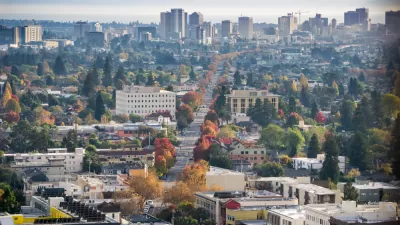The nation's most populous state learned from the Census Bureau last month that it would lose a congressional district for the first time in its history. On Friday, it revealed that 2020 was the first year since 1850 to experience a population loss.

What about domestic migration?
The press release did not include domestic migration data. of the nonprofit journalism venture, CalMatters, reported on that aspect of the demographic data in the source article that was explicitly noted in the title, "don't call it an exodus."
The number of Californians who have left the state for more affordable corners of the union has also been a drag on the state’s head count for three decades. That “net-domestic outmigration” exceeded the number of new immigrants from around the world for the first time in 2018, according to Department of Finance estimates.
Department of Finance spokesperson H.D. Palmer went out of his way to stress that Californians packing it up for Texas and Colorado are not the primary cause of the state’s striking population decline.
“Some people who run with statistical scissors will try to extrapolate or hyperventilate that this is evidence of some sort of ‘Mad Max’ style ‘exodus’ from California and that is not the case,” he said.
Recall politics
As if on cue, Kevin Faulconer, the former mayor of San Diego and now a prominent Republican candidate hoping to replace Democratic Gov. Gavin Newsom in the upcoming recall election, tweeted:
The numbers don’t lie. People are leaving our state because it’s not affordable to live here. One party rule has made it almost impossible to raise a family.
"But a new analysis from the Public Policy Institute of California says the state remains as attractive as ever for the well-off," adds Christopher. The analysis was released the day before the Finance Department issued its population estimates.
It’s people in the working and middle classes who are leaving, largely due to high housing and other costs. “In the past five years the flow of middle-income residents out of the state has accelerated,” wrote Hans Johnson, a demographer with the institute.
Additional reading on the first-ever population decline in California, all published on May 7:
- AP: "California leaving: State population declines for first time," by Adam Beam
- Sacramento Bee: "California’s population declined for the first time ever last year. Here’s why," by Kim Bojórquez
- San Francisco Chronicle: "It had never happened in a century: California's population drops", by Alexei Koseff
Census winners and losers
California was the only state not in the Midwest or Mid-Atlantic that will lose a congressional district next year as a result of the 2020 Census apportionment data released on April 26 (see related blog post, "3 Takeaways From 2020 Census Apportionment Data").
The other six states that will each lose one congressional representative:
- Three Mid-Atlantic states: New York, Pennsylvania, West Virginia
- Three Mid-Western states: Ohio, Illinois, Michigan
The six winners:
- Texas gained two seats
- Southern states: Florida and North Carolina each gained one seat
- Western states: Oregon, Montana and Colorado gained one seat
Related in Planetizen:
- 3 Takeaways From 2020 Census Apportionment Data, April 28, 2021
-
California's Population Might Be Peaking, May 26, 2020
-
California Has Been Shedding Residents—For Decades, March 3, 2018
FULL STORY: California’s population shrank in 2020, but don’t call it an exodus

Manufactured Crisis: Losing the Nation’s Largest Source of Unsubsidized Affordable Housing
Manufactured housing communities have long been an affordable housing option for millions of people living in the U.S., but that affordability is disappearing rapidly. How did we get here?

Americans May Be Stuck — But Why?
Americans are moving a lot less than they once did, and that is a problem. While Yoni Applebaum, in his highly-publicized article Stuck, gets the reasons badly wrong, it's still important to ask: why are we moving so much less than before?

Research Shows More Roads = More Driving
A national study shows, once again, that increasing road supply induces additional vehicle travel, particularly over the long run.

Minneapolis Bans Rent-Setting Software
Four cities have enacted restrictions on algorithmic software that can inflate rent costs.

Oakland to Add 244 New EV Chargers
Oakland plans to launch its new charging network at eight locations by the end of 2025.

Jane Goodall Inspires with Message of Hope, Resilience, and Environmental Action
Speaking in Pasadena, Jane Goodall offered a hopeful and inspirational message, urging global compassion, environmental responsibility, and the power of individual action to shape a better future.
Urban Design for Planners 1: Software Tools
This six-course series explores essential urban design concepts using open source software and equips planners with the tools they need to participate fully in the urban design process.
Planning for Universal Design
Learn the tools for implementing Universal Design in planning regulations.
Heyer Gruel & Associates PA
City of Moreno Valley
Institute for Housing and Urban Development Studies (IHS)
City of Grandview
Harvard GSD Executive Education
NYU Wagner Graduate School of Public Service
City of Cambridge, Maryland
Newport County Development Council: Connect Greater Newport





























